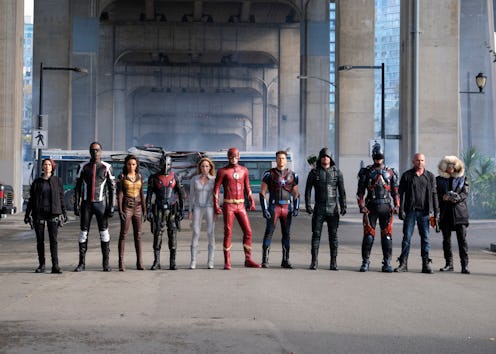Entertainment
The CW’s New DC Superhero Is About To Bust Some Barriers

"The Crisis On Earth-X" DC crossover is soon to be in full swing, uniting the TV universes of The Flash, Legends Of Tomorrow, Arrow, and Supergirl all into one overarching storyline, beginning on Nov. 27. Joining the existing team members will be Raymond Terrill, played by Russell Tovey from Looking and Quantico. The four-way crossover is borrowing "The Ray" from DC comics.
There have been four different iterations of The Ray in the comics, but Raymond Terrill is the one who'll be appearing on TV. Raymond made his first appearance in DC comics in 1992, starting his own series. He is the son of the original Golden Age era superhero, Happy Terrill, who first carried the name "The Ray." However, Raymond doesn't learn that until his 18th birthday. On that day, the man he believed to be his father tells him he is actually his uncle.
Raymond had lived isolated in the dark for years, as he was told during his childhood that exposure to sunlight would kill him. In actuality, the light of the sun would end up fueling his vast array of light-based superhuman abilities. After the initial shock of this information, Raymond moves on. Honing his superpowers with a bit of nudging from his real father, he goes on to become a member of The Justice League as well as a number of other superhero teams.
However, his comic book origins tell a strikingly different backstory than the one we’ll meet in the crossover. According to a synopsis of his character from The CW, this version of the character doesn't have his powers from birth. Instead, he receives the powers after an attempt on his life.
“Raymond “Ray” Terrill was a reporter who discovered a group of government scientists working on a secret project to turn light into a weapon of mass destruction," the description reads, according to TV Line. "But before he could report on his findings, the project head exposed Ray to a 'genetic light bomb.' The bomb failed to kill him and instead gifted Ray with light-based powers. With these abilities, Ray realized he could go beyond reporting on injustice — he could take action to help stop it. Calling himself The Ray, he was recruited by Uncle Sam and the Freedom Fighters to fight violence and oppression wherever it exists.”
Ray will be making the jump from the pages of comic books to not just the CW DC crossover, but also to an animated series named after him. Freedom Fighters: The Ray will air on the web channel, CW Seed. In both the animated and the live action versions, he’ll be portrayed by Russell Tovey and be openly gay. In both the crossover and Freedom Fighters, The Ray will be trying to achieve the same goal: stop Nazis.
"The Crisis On Earth-X" crossover (and the new CW Seed show), deal with a parallel universe in which the Nazis won World War II. That means that heroes like Supergirl can become villains in other Earths, in this case, sporting the infamous symbol of the Nazi SS.
So, why is a relatively minor DC character like The Ray getting his own series named after him, and a prominent role in the CW crossover? According to the series executive producer Marc Guggenheim's interview with TV Insider, The Ray's identity is important for the franchise to showcase, especially in facing this foe. He said:
“In [the comic series] Multiversity, Grant Morrison came up with an idea we really responded to: The Freedom Fighters are made up of various minorities targeted by Nazis — women, gay men, Jews. We wanted to honor that idea. At the same time, it’s an origin story about the Earth-1 iteration of The Ray.”
As an out, gay superhero, Ray's inclusion and celebration is significant. Not only that, but his identity is essential to why he uses his powers. He is defending marginalized groups from an evil, historic, totalitarian force. It remains to be seen just what else, in addition to his backstory, may have changed in updating this longstanding superhero from the comics. But he's about to break out in two new adaptations, on the back of a spectacular crossover event.